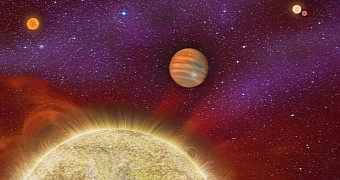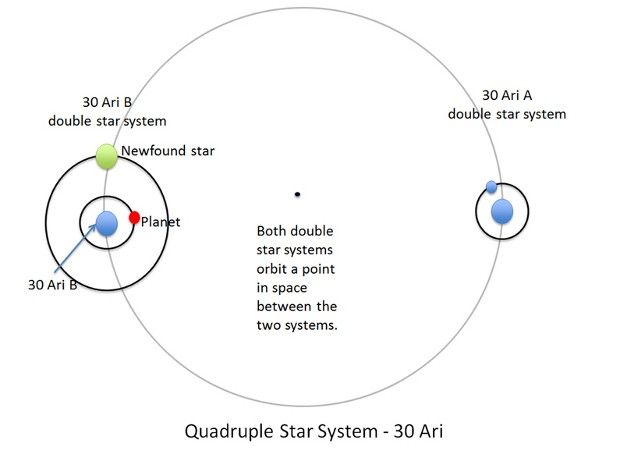Just yesterday, astronomers with NASA announced the discovery of a fairly bizarre cosmic system comprising four stars and a gaseous planet 10 times heavier than Jupiter, whose estimated mass is about two and a half times greater than that of all the other planets in the Solar System combined.
This cosmic system, known as 30 Ari, is located at a distance of about 136 light-years from our planet, in the constellation Aries. The gaseous giant that is part and parcel of its anatomy is only the second planet thus far discovered to be part of a quadruple star system.
30 Ari's anatomy and dynamics, as explained by astronomers
As shown in the image below, the odd cosmic system comprises two pairs of stars that orbit the same point in space. Of these stars, two sit especially close to one another and form a binary system, which means that their orbits carry them around another common point in space.
The other two stars that comprise this system, shown on the left side of the image, sit further apart. It was only recently that astronomers discovered one of these two celestial bodies. Thus, for quite a while, it was believed that 30 Ari had not four stars, but three.
It is estimated that these two pairs of stars sit at a distance of about 1,670 astronomical units from one another. In case anyone was wondering, an astronomical unit is defined as a distance equivalent to that between Earth and its own parent star, the Sun.
The massive gaseous planet included in this cosmic system takes 335 days to orbit its primary star. Astronomers say that, should one find themselves on this planet and look at the sky, they would see a small sun and two bright stars visible even in daylight.
At a closer look, one of these bright stars would be revealed as the binary system that forms half of the 30 Ari quadruple star system. For the time being, scientists cannot say whether the planet has any moons that could also appear on the sky above it.
The same study led to the discovery of a triple-star system
NASA astronomers say that 30 Ari was revealed to be a quadruple system with the help of telescopes at the Palomar Observatory in San Diego, US. The same instruments served to discover a triple-star system dubbed HD 2638. This system is also home to a gaseous giant similar to our Jupiter.
It is understood that this other planet has an orbit of just 3 days. Its primary star is interlocked with two other celestial bodies of its kind, of which one is located at a distance of 44,000 astronomical units away from it and the other is as close as 28 astronomical units.
Commenting on the discovery of 30 Ari's and HD 2638's peculiar anatomies, study lead author Lewis Roberts said, “Star systems come in myriad forms. There can be single stars, binary stars, triple stars, even quintuple star systems. It's amazing the way nature puts these things together.”

 14 DAY TRIAL //
14 DAY TRIAL // 

